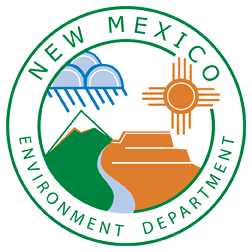Additional Surface Water Quality Permitting Program information available here.
FAQ LIST
- What is the purpose and scope of the proposed surface water quality state permitting program?
- What is the difference between “waters of the U.S.” and “surface waters of the state”, and why does it matter?
- Does New Mexico need new statutes or rules for this program?
- How will the state permitting program affect surface waters on tribal lands?
- How will the state permitting program affect water rights?
- Will the surface water quality state permitting program provide compliance assistance or incentives?
- How long will it take to get the surface water quality state permitting program up and running?
- What steps are required for New Mexico to obtain EPA approval to implement the NPDES part of the program?
- How will the surface water quality state permitting program be staffed and funded?
- Does NMED have an accessible and functional database to implement a state permitting program?
- How many NPDES permittees are there in New Mexico?
- Who do I contact for questions about my existing NPDES or Section 404 permit?
- How do I report a water quality or wetlands concern or a possible violation of water quality standards?
- How will NMED keep the public informed about development of the surface water quality state permitting program?
1. What is the purpose and scope of the proposed surface water quality state permitting program?
The purpose of the proposed permitting program is to protect surface waters of the state from pollution and degradation. There are two main categories of pollution – point source and nonpoint source. Point source pollution comes from a single source, whereas nonpoint source pollution comes from many sources across the landscape. The program will require industrial, municipal, and other facilities to obtain permits from NMED to control the discharge of pollutants if they discharge contaminants from point sources into surface waters, including wetlands. The program will not apply to nonpoint source pollution, and the program will not require permits for the use of water in irrigated agriculture, consistent with the Water Quality Act (NMSA 1978 Section 74-6-4, Paragraph M).
2. What is the difference between “waters of the U.S.” and “surface waters of the state”, and why does it matter?
“Waters of the U.S.” (WOTUS) refers to those surface waters protected by the federal Clean Water Act. “Surface waters of the state” refers to those surface waters protected by New Mexico’s Water Quality Act.
For many years, “waters of the U.S.” was broadly defined to include most surface waters in New Mexico. Recent U.S. Supreme Court decisions have scaled back the term’s meaning to the point that many surface waters in New Mexico may no longer be considered waters of the U.S. For instance, ephemeral streams, such as arroyos that flow only in response to precipitation, and many wetlands may not be protected from contamination and degradation under the federal Clean Water Act.
The New Mexico Water Quality Act authorizes the New Mexico Quality Control Commission (WQCC) to adopt water quality standards for surface waters of the state. The WQCC has broadly defined “surface waters of the State” in the water quality standards (20.6.4.7(S) NMAC), and a state permitting program would issue permits to protect surface waters of the state, which include waters of the U.S., from discharges of pollutants.
3. Does New Mexico need new statutes or rules for this program?
The New Mexico Water Quality Act provides broad authority for the state to adopt a discharge permitting program for state waters, but amendments may be required. To obtain NPDES delegation, the state must enact a new statute that meets EPA requirements. For NMED to implement all aspects of the new program, the New Mexico Water Quality Control Commission will have to adopt new rules.
4. How will the state permitting program affect surface waters on tribal lands?
The recent changes to the definition of Waters of the U.S. may put some tribal waters at risk from upstream discharges. A state permitting program will not give New Mexico any authority over tribal waters, but will ensure that discharges into surface waters that flow onto tribal lands will not violate tribal water quality standards.
5. How will the state permitting program affect water rights?
State law prohibits water quality permitting from affecting water rights. On the other hand, the program will protect water quality for all uses, including drinking water, irrigation, recreation, and fish and wildlife.
6. Will the surface water quality state permitting program provide compliance assistance or incentives?
NMED recognizes that interpreting and complying with state rules can be difficult and confusing, especially for smaller permittees. NMED intends to dedicate technical staff to provide compliance assistance, and will consider proposing incentives to encourage dischargers to adopt pollution controls that are better than the applicable requirements.
7. How long will it take to get the surface water quality state permitting program up and running?
NMED estimates it will take until 2027 to begin issuing permits under the new program. The New Mexico Water Quality Control Commission must adopt a rule to establish the state permit part of the program, and obtain EPA’s approval to implement the NPDES part of the program. Please see the projected timeline on this webpage.
8. What steps are required for New Mexico to obtain EPA approval to implement the NPDES part of the program?
The state must submit an application to EPA that demonstrates it has the legal authority to implement the NPDES program. This demonstration will require the state to adopt a new statute and rule. After approval, the state will phase in the NPDES part of the program over a five-year period. Until EPA approves the state’s application, and consistent with the phase-in period, EPA will continue to issue and enforce NPDES permits in New Mexico.
9. How will the surface water quality state permitting program be staffed and funded?
Most states fund their permitting programs with a combination of fees, federal grants, and legislative appropriations. New Mexico has the flexibility to create its own funding approach, but the funding must be sustainable over the long term.
NMED estimates that the program will require 35-50 employees, including managers and technical, financial, human resources, legal, and administrative staff. Technical staff will be located around the state to provide better service. Factoring in overhead costs such as office space, vehicles, equipment, and supplies, NMED estimates the cost at full program implementation will be in the range of $6-9 million per year. The actual cost could vary depending on the program scope and requirements.
The Surface Water Quality Bureau already has seven (7) technical staff who certify NPDES permits and assist EPA with compliance and enforcement. In addition, the Bureau has hired three (3) technical staff to develop the program, and who will transition into new roles after the program is started.
10. Does NMED have an accessible and functional database to implement a state permitting program?
NMED is working with a contractor to develop a database that can be used for electronic permitting and reporting for both the existing groundwater discharge permitting program and the proposed surface water quality permitting program.
11. How many NPDES permittees are there in New Mexico?
There are approximately 4,000 NPDES permittees in New Mexico. This number fluctuates over time. The table below summarizes the number of permits by type, as of October 30, 2023. Please click here to see a map.
| # Permittees | Types of NPDES Permits |
| 89 | Permittees with individual permits, such as municipal wastewater treatment plants and industrial facilities. The map shows only one location for each permittee, but some permittees have multiple outfalls (an outfall is the location where a discharge enters a surface water). These permits regulate over 200 outfalls. |
| 512 | Permittees with stormwater coverage under the Industrial Multi-Sector General Permit (MSGP). |
| 21 | Permittees with stormwater coverage under the Concentrated Animal Feeding Operations (CAFO) General Permit. |
| 3,172 | Permittees with stormwater coverage under the Construction General Permit (CGP). |
| 35 | Permittees with coverage under the Municipal Separate Storm Sewer System (MS4) General Permit. These permittees are not shown on the map, but MS4 permits currently apply to urbanized areas in the Middle Rio Grande Watershed, as well as the cities of Farmington, Los Alamos, Las Cruces, El Paso, and Santa Fe. |
| 10 | Permittees with coverage under the Pesticide General Permit (PGP). These permittees are not shown on the map. |
12. Who do I contact for questions about my existing NPDES or Section 404 permit?
NMED does not issue NPDES or Section 404 permits in the state, so please direct your questions to the following contacts:
Section 402 (NPDES): U.S. EPA Region 6
- Individual Permits: Tung Nguyen, Nguyen.Tung@epa.gov or 214-665-7153
- CAFOs, Pesticides, and Biosolids: William Cooper, Cooper.WilliamF@epa.gov or 214-665-6443
- Construction General Permits: Suzanna Perea, Perea.Suzanna@epa.gov or 214-665-7217
- Industrial General Permits: Nasim Jahan, Jahan.Nasim@epa.gov or 214-665-7522
- MS4 General Permits: Monica Burrell, Burrell.Monica@epa.gov or 214-665-7530
- Hydrostatic Test General Permit: Maria Okpala, Okpala.Maria@epa.gov or 214-665-3152
Section 404 (Dredge/Fill): U.S. Army Corps of Engineers
- See this webpage for contacts by county: Regulatory Program and Permits Webpage
13. How do I report a water quality or wetlands concern or a possible violation of water quality standards?
Please visit this NMED website to file a report: https://www.env.nm.gov/general/report-an-environmental-issue-or-incident/.
14. How will NMED keep the public informed about development of the surface water quality state permitting program?
If you would like to stay informed as NMED develops the program, please sign up for email updates by sending an email to swq.pp@env.nm.gov. You also can check for updates on this website.
After NMED starts implementing the program, it will issue public notice for draft permits and public hearings so that interested persons can participate in the process.

